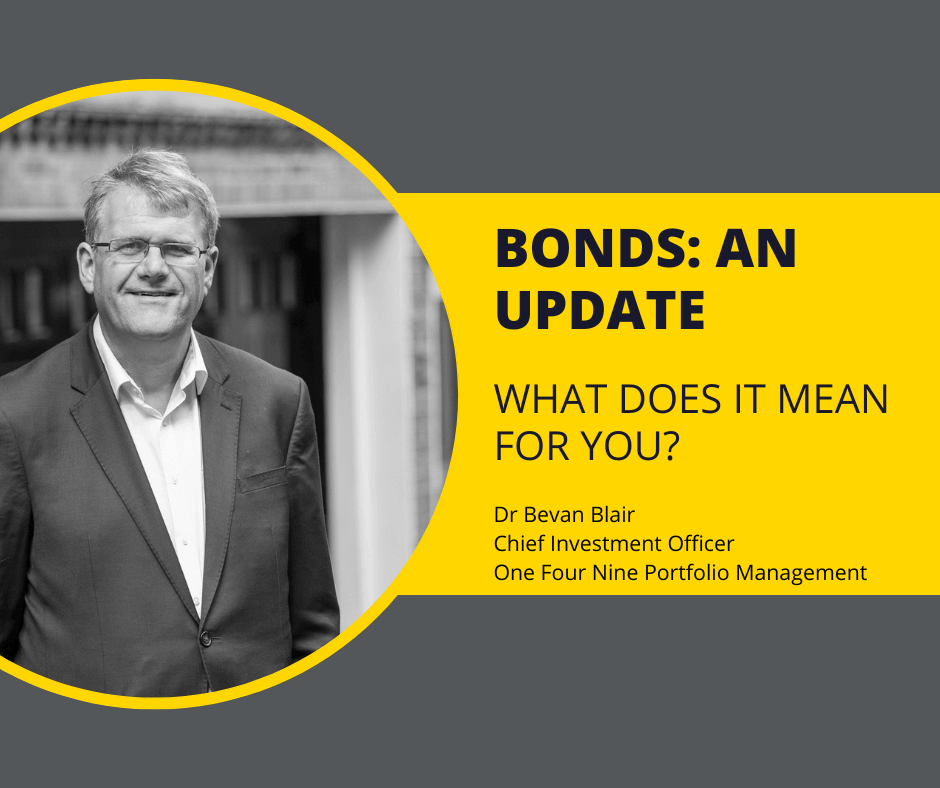For professional use only. This article is for information purposes and should not be considered financial advice
Most people will have seen that there is a relatively high degree of turmoil going on in financial markets however not everyone will have an understanding of the issues and how they might affect their investments.
We have put together the following discussion points to assist you in your conversations with clients.
Blending asset types to control risk
- In our investment portfolios, we hold low risk assets such as bonds – government and corporate, property and other ‘real’ assets (infrastructure) to protect investors from the worst excesses of equity (share) markets
- We expect these assets not to suffer large drawdowns as they have a much lower volatility than equity (share) markets; historically they have been nearly 2/3rds less risky than equity markets
How do bonds work?
- Bonds are considered less risky because they have known cash flows – a regular interest payment (or coupon) paid each year reflecting the interest rate, as well as the repayment of your money back at the end of the life of the bond; the only long-term risk is that the company or government defaults on paying you these coupons and/or your principal (capital)
- Bonds are normally issued at what is called par – a nominal £100. Over the lifetime of the bond the price of the bond can differ from par, either above or below depending on where interest rates are. If a bond is above par, then it is likely that interest rates are lower than when the bond was first issued. As interest rates rise (fall) the prices of bonds fall (rise)
- The annual coupon you get can cushion you from falls in the bond price; the higher the interest rate the higher the cushion. Low coupons mean that there is less of a cushion from falls in the short term
What has happened over recent years?
- For the last few years, bonds have been at high prices, generally above par, as interest rates have been historically low. More recent bond issues also have had low coupons with less cushion available to investors
- This has meant that there has been an asymmetric risk of loss from rises in interest rates. Bond prices have been high and increasing rates will reduce those prices back towards, and sometime through par, and there has been less cushion available from coupons. Capital has been at risk
How has this changed more recently
- This year we have experienced a rapid rise in base rates and interest rate expectations on the back of high levels of inflation and the willingness of central banks to combat inflation at the expense of growth. This has been a global phenomenon, although in the most part it has been orderly
- The effect has been to reduce bond prices significantly. This has been compounded by the fact that interest rates were very low, and so bond prices were high
- Bonds therefore have seen unprecedented falls in value this year and in particular the last two months. UK Government debt (Gilts) have fallen 30% this year – this has never happened before
- While earlier falls in the year have been caused by a rising rate environment the ferocious upward movement in rates in the past two months has been a direct consequence of the Government’s mini-budget, u-turns and deck changing
- Meanwhile the riskiness of bonds has soared as a consequence. Bonds this year have been nearly twice as risky as equities and in the past two months they have been 3 times as risky
What does it mean for me?
- In the short term, bonds have lost their ability to protect clients’ assets; this has had a knock-on effect in other asset classes, in particular commercial property, and real assets. These have fallen because yields have risen, and investors have sold these to take advantage of higher interest rates; there has been a massive yield substitution effect – again protection has been lacking
- These movements have had a disproportionate effect on low-risk portfolios, with lower risk portfolios suffering larger losses than higher risk portfolios. Our portfolios at the low-risk end have suffered falls this year, but have not participated in the extreme falls we have witnessed
- This has been a truly ‘black swan’ event; what may have taken years in terms of rising rates has taken place in a matter of months
How have we handled this?
- At OFNPM, we focus on protecting capital and managing risk which is intended to provide our clients with a smoother return profile, allowing them to achieve a greater degree of certainty in the fulfilment of their long-term financial plans
- We have protected our portfolios from the volatility in bond markets and its subsequent losses by either holding cash or keeping our bond exposure to those bonds that have less sensitively to rising rates. These tend to be bonds that mature within 5 years. We saw the risk on the downside in mid-2020 and moved portfolios to protect capital from falls in bond markets but even we have been surprised by the ferocity of the movement
Looking to the future
- In the short term while the UK government remains utterly dysfunctional we should expect to see higher volatility in the bond market, especially while we wait for a new budget
- There is some end in sight for low-risk investors. Once volatility in bond markets dies down, perhaps through calmer Government and central bank policies, portfolios should start to recover, although it will be slow
- Inflation is showing signs of peaking and the rate of increase is starting to slow; the market is expecting the current rate rising cycle to end in mid-2023 and then there may be room for rate cuts as inflation comes under control. This should be positive for bonds, but now is not the time to buy more as the risks remain high. We continue to maintain our low-risk position and stick to our knitting
- We do however expect to see better returns in the long term (10 years) as the risk-free rate increases and lifts potential asset returns
Find out more about One Four Nine Portfolio Management here.
Dr Bevan Blair,
Chief Investment Officer,
One Four Nine Portfolio Management
London, Tuesday 25 October 2022.
For professional use only. This article is for information purposes and should not be considered financial advice
All investment views are presented for information only and are not a personal recommendation to buy or sell. Past performance is not a reliable indicator of future returns, investing involves risk and the value of investments and the income from them may fall as well as rise and are not guaranteed. Investors may not get back the original amount invested.











